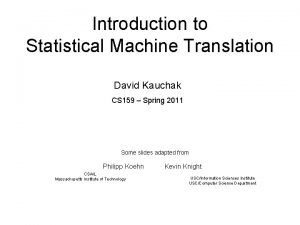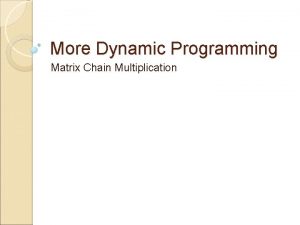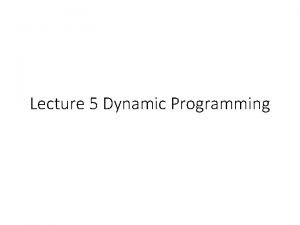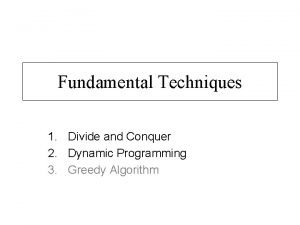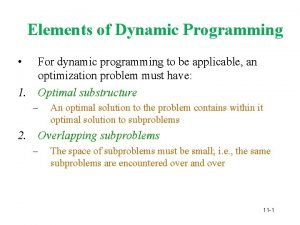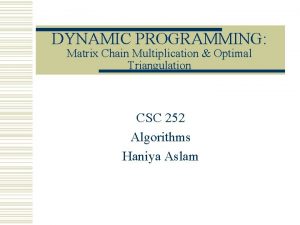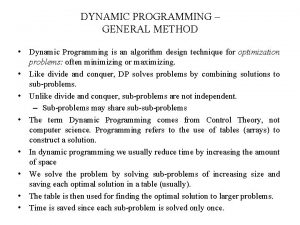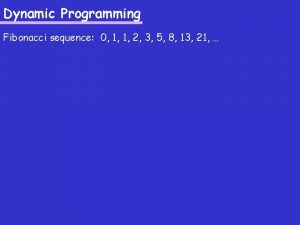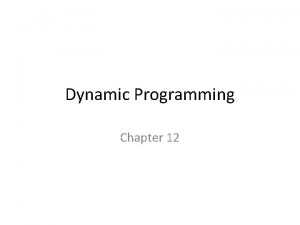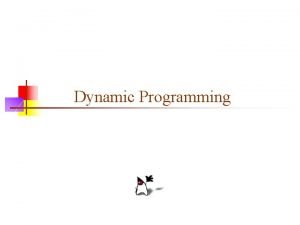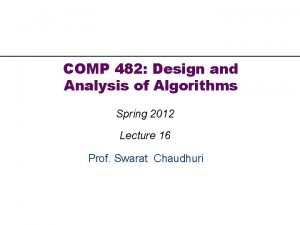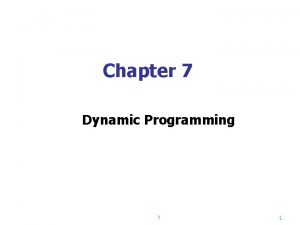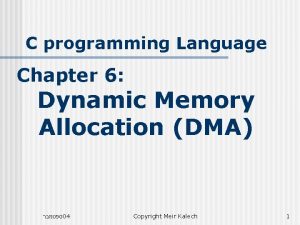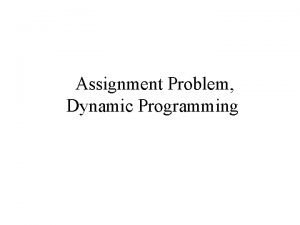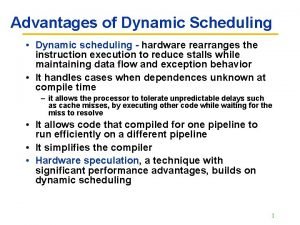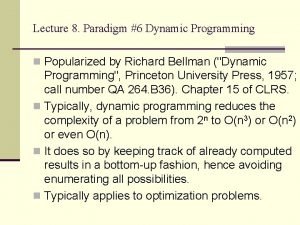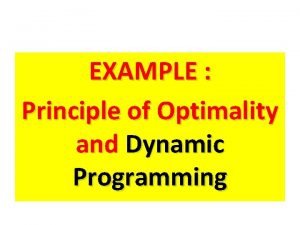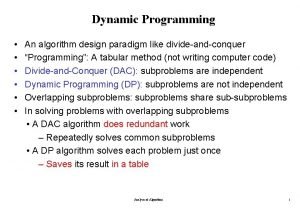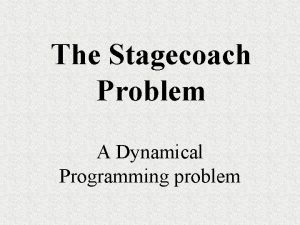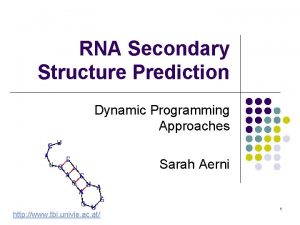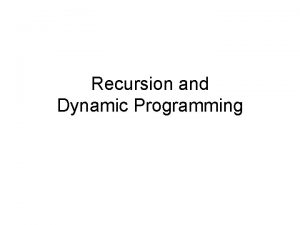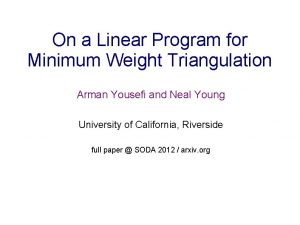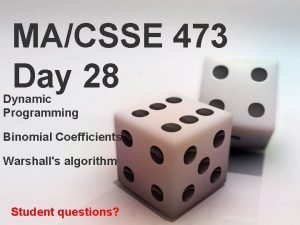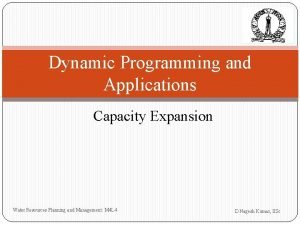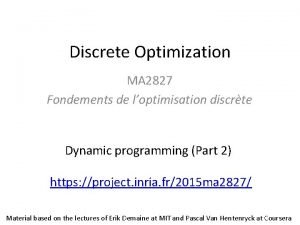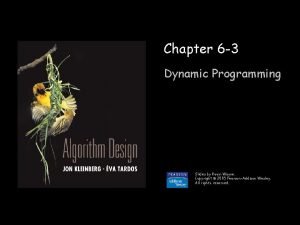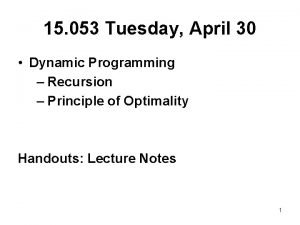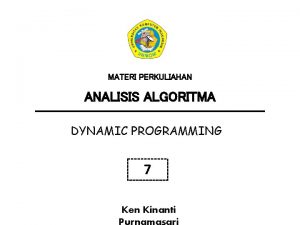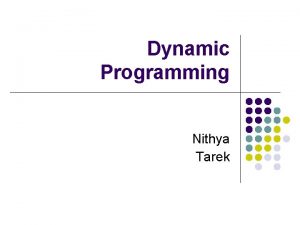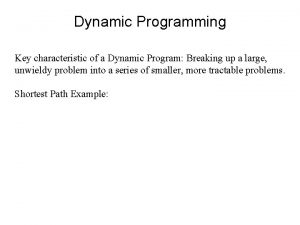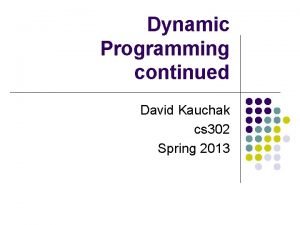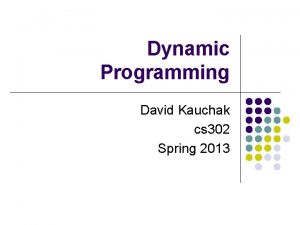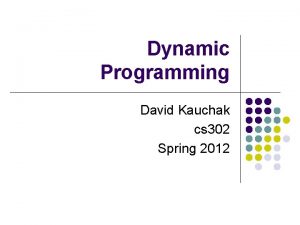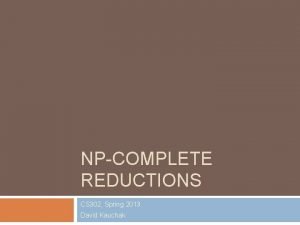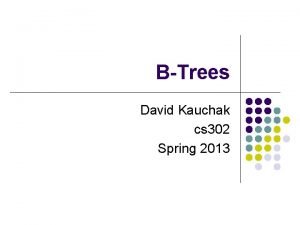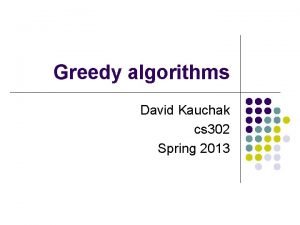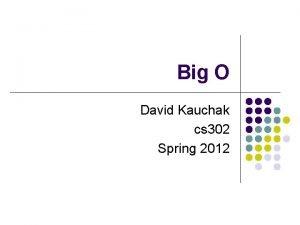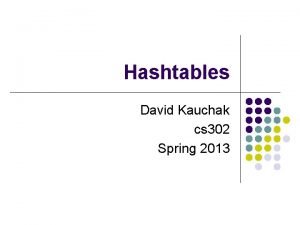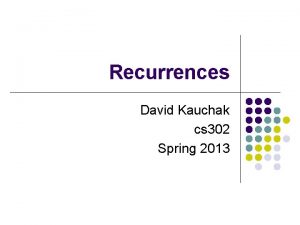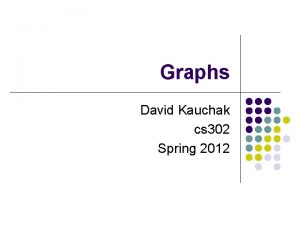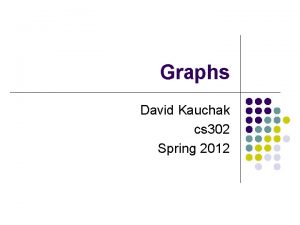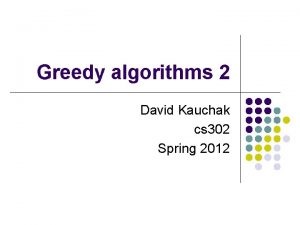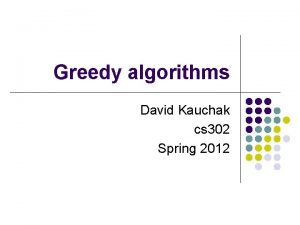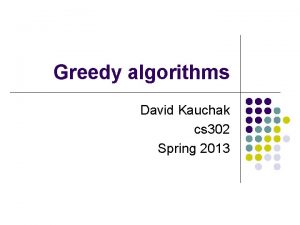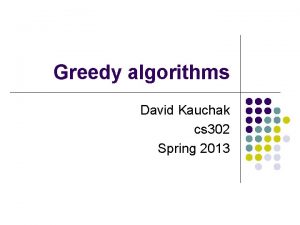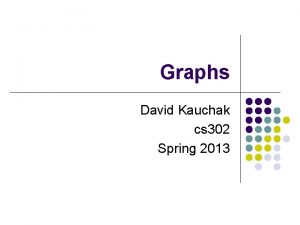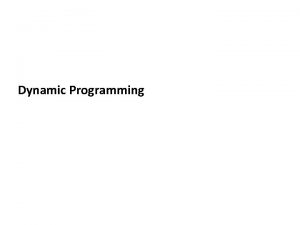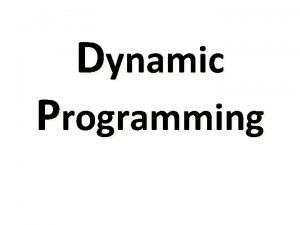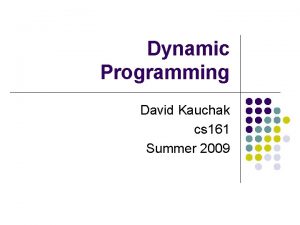Dynamic Programming continued David Kauchak cs 302 Spring




















































- Slides: 52

Dynamic Programming continued David Kauchak cs 302 Spring 2012

Admin l CS lunch Thursday after class

Longest common subsequence (LCS) For a sequence X = x 1, x 2, …, xn, a subsequence is a subset of the sequence defined by a set of increasing indices (i 1, i 2, …, ik) where 1 ≤ i 1 < i 2 < … < ik ≤ n X=ABACDABAB ABA?

Step 1: Define the problem with respect to subproblems X=ABCBDAB Y=BDCABA (for now, let’s just worry about counting the length of the LCS)

Step 2: Build the solution from the bottom up LCS(X 1…j, Y 1…k)

j i 0 1 2 3 4 5 6 7 xi A B C B D A B 0 1 2 34 5 6 yj B D C A B A 0 0 0 0 0 1 1 1 2 2 2 000 011 112 223 223 234 0 1 2 2 3 3 4 4

LCS Algorithm Θ(nm)

Keeping track of the solution Our LCS algorithm only calculated the length of the LCS between X and Y What if we wanted to know the actual sequence? Keep track of this as well…

j i 0 1 2 3 4 5 6 7 xi A B C B D A B 0 1 2 34 5 6 yj B D C A B A 0 0 0 0 0 1 1 1 2 2 2 000 011 112 223 223 234 0 1 2 2 3 3 4 4 We can follow the arrows to generate the solution

j i 0 1 2 3 4 5 6 7 xi A B C B D A B 0 1 2 34 5 6 yj B D C A B A 0 0 0 0 0 1 1 1 2 2 2 000 011 112 223 223 234 0 1 2 2 3 3 4 4 We can follow the arrows to generate the solution BCBA

Longest increasing subsequence Given a sequence of numbers X = x 1, x 2, …, xn find the longest increasing subsequence (i 1, i 2, …, ik), that is a subsequence where numbers in the sequence increase. 5 2 8 6 3 6 9 7

Longest increasing subsequence Given a sequence of numbers X = x 1, x 2, …, xn find the longest increasing subsequence (i 1, i 2, …, ik), that is a subsequence where numbers in the sequence increase. 5 2 8 6 3 6 9 7

Step 1: Define the problem with respect to subproblems 5 2 8 6 3 6 9 7 Two options: Either 5 is in the LIS or it’s not

Step 1: Define the problem with respect to subproblems 5 2 8 6 3 6 9 7 include 5 5 + LIS(8 6 3 6 9 7)

Step 1: Define the problem with respect to subproblems 5 2 8 6 3 6 9 7 include 5 5 + LIS(8 6 3 6 9 7) What is this function exactly? longest increasing sequence of the numbers starting with 8

Step 1: Define the problem with respect to subproblems 5 2 8 6 3 6 9 7 include 5 5 + LIS(8 6 3 6 9 7) What is this function exactly? longest increasing sequence of the numbers This would allow for the option of sequences starting with 3 which are NOT valid!

Step 1: Define the problem with respect to subproblems 5 2 8 6 3 6 9 7 include 5 5 + LIS’(8 6 3 6 9 7) longest increasing sequence of the numbers starting with 8 Do we need to consider anything else for subsequences starting at 5?

Step 1: Define the problem with respect to subproblems 5 2 8 6 3 6 9 7 include 5 5 + LIS’(8 6 3 6 9 7) 5 + LIS’(6 9 7) 5 + LIS’(7)

Step 1: Define the problem with respect to subproblems 5 2 8 6 3 6 9 7 don’t include 5 LIS(2 8 6 3 6 9 7) Anything else? Technically, this is fine, but now we have LIS and LIS’ to worry about. Can we rewrite LIS in terms of LIS’?

Step 1: Define the problem with respect to subproblems Longest increasing sequence for X is the longest increasing sequence starting at any element And what is LIS’ defined as (recursively)?

Step 1: Define the problem with respect to subproblems Longest increasing sequence for X is the longest increasing sequence starting at any element Longest increasing sequence starting at i

Step 2: build the solution from the bottom up LIS’: 5 2 8 6 3 6 9 7

Step 2: build the solution from the bottom up LIS’: 1 5 2 8 6 3 6 9 7

Step 2: build the solution from the bottom up LIS’: 1 5 2 8 6 3 6 9 7

Step 2: build the solution from the bottom up LIS’: 1 1 5 2 8 6 3 6 9 7

Step 2: build the solution from the bottom up LIS’: 1 1 5 2 8 6 3 6 9 7

Step 2: build the solution from the bottom up LIS’: 2 1 1 5 2 8 6 3 6 9 7

Step 2: build the solution from the bottom up LIS’: 3 2 1 1 5 2 8 6 3 6 9 7

Step 2: build the solution from the bottom up LIS’: 2 3 2 1 1 5 2 8 6 3 6 9 7

Step 2: build the solution from the bottom up LIS’: 2 2 3 2 1 1 5 2 8 6 3 6 9 7

Step 2: build the solution from the bottom up LIS’: 4 2 2 3 2 1 1 5 2 8 6 3 6 9 7

Step 2: build the solution from the bottom up LIS’: 3 4 2 2 3 2 1 1 5 2 8 6 3 6 9 7

Step 2: build the solution from the bottom up LIS’: 3 4 2 2 3 2 1 1 5 2 8 6 3 6 9 7

Step 2: build the solution from the bottom up

Step 2: build the solution from the bottom up start from the end (bottom)

Step 2: build the solution from the bottom up

Step 2: build the solution from the bottom up

Step 2: build the solution from the bottom up initialization?

Running time? Θ(n 2)

Another solution l Can we use LCS to solve this problem? 5 2 8 6 3 6 9 7 LCS 2 3 5 6 6 7 8 9

Another solution l Can we use LCS to solve this problem? 5 2 8 6 3 6 9 7 LCS 2 3 5 6 6 7 8 9

Memoization l Sometimes it can be a challenge to write the function in a bottom-up fashion l Memoization: l l Write the recursive function top-down Alter the function to check if we’ve already calculated the value If so, use the pre-calculate value If not, do the recursive call(s)

Memoized fibonacci

Memoized fibonacci

Memoized fibonacci Use to denote uncalculated

Memoized fibonacci What else could we use besides an array? Use to denote uncalculated

Memoized fibonacci Check if we already calculated the value

Memoized fibonacci calculate the value

Memoized fibonacci store the value

Memoization l Pros l l l Can be more intuitive to code/understand Can be memory savings if you don’t need answers to all subproblems Cons l Depending on implementation, larger overhead because of recursion (though often the functions are tail recursive)

Quick summary l Step 1: Define the problem with respect to subproblems l l l We did this for divide and conquer too. What’s the difference? You can identify a candidate for dynamic programming if there is overlap or repeated work in the subproblems being created Step 2: build the solution from the bottom up l l Build the solution such that the subproblems referenced by larger problems are already solved Memoization is also an alternative

0 -1 Knapsack problem l 0 -1 Knapsack – A thief robbing a store finds n items worth v 1, v 2, . . , vn dollars and weight w 1, w 2, …, wn pounds, where vi and wi are integers. The thief can carry at most W pounds in the knapsack. Which items should the thief take if he/she wants to maximize value? l Repetition is allowed, that is you can take multiple copies of any item
 Cs 451
Cs 451 David kauchak
David kauchak David kauchak
David kauchak David kauchak
David kauchak David kauchak
David kauchak David kauchak
David kauchak David kauchak
David kauchak Greedy vs dynamic programming
Greedy vs dynamic programming Introduction to teaching becoming a professional
Introduction to teaching becoming a professional Kim ki duk spring summer fall winter
Kim ki duk spring summer fall winter What months are fall
What months are fall Spring mvc 아이디 찾기
Spring mvc 아이디 찾기 Dynamic dynamic - bloom
Dynamic dynamic - bloom Tabulation dynamic programming
Tabulation dynamic programming Matrix chain multiplication ppt
Matrix chain multiplication ppt Knapsack dynamic programming pseudocode
Knapsack dynamic programming pseudocode Dynamic programming
Dynamic programming Divide and conquer
Divide and conquer Dynamic programming algorithm
Dynamic programming algorithm Dynamic programming vs divide and conquer
Dynamic programming vs divide and conquer Dynamic programming general method
Dynamic programming general method Dynamic programming in excel
Dynamic programming in excel Fibonacci series dynamic programming
Fibonacci series dynamic programming Egg drop algorithm
Egg drop algorithm Divide and conquer greedy algorithm
Divide and conquer greedy algorithm Dynamic programming algorithm
Dynamic programming algorithm Segmented least squares dynamic programming
Segmented least squares dynamic programming Multistage graph forward approach
Multistage graph forward approach Dynamic c programming
Dynamic c programming Assignment problem dynamic programming
Assignment problem dynamic programming Benefits of dynamic scheduling software
Benefits of dynamic scheduling software Advanced dynamic programming
Advanced dynamic programming Dynamic problem
Dynamic problem Dynamic programming paradigm
Dynamic programming paradigm Optimality principle in dynamic programming
Optimality principle in dynamic programming Dynamic programming paradigm
Dynamic programming paradigm Disadvantages of array
Disadvantages of array Gerrymandering dynamic programming
Gerrymandering dynamic programming Stagecoach problem
Stagecoach problem Canonical base
Canonical base Recursive thought
Recursive thought Minimum weight triangulation dynamic programming
Minimum weight triangulation dynamic programming Binomial coefficient using dynamic programming
Binomial coefficient using dynamic programming Manhattan tourist problem dynamic programming
Manhattan tourist problem dynamic programming Dynamic programming recursion example
Dynamic programming recursion example Blackjack dynamic programming
Blackjack dynamic programming Dynamic programming slides
Dynamic programming slides Dynamic programming recursion example
Dynamic programming recursion example Dynamic programming equation
Dynamic programming equation Contoh algoritma dynamic programming
Contoh algoritma dynamic programming Dynamic programming
Dynamic programming Characteristics of dynamic programming
Characteristics of dynamic programming Dynamic programming in excel
Dynamic programming in excel



